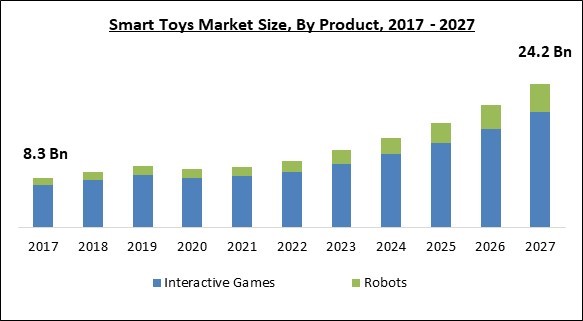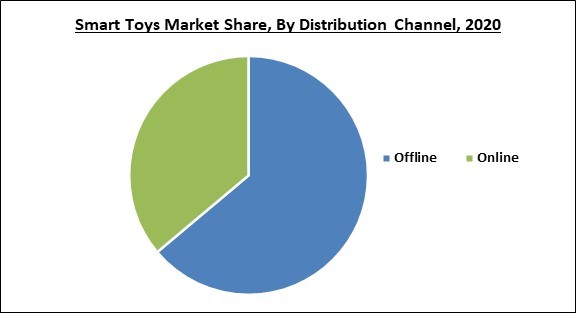The Global Smart Toys Market size is expected to reach $24.2 billion by 2027, rising at a market growth of 15.4% CAGR during the forecast period.
A smart toy is an interactive toy that practically possesses its own intelligence which is attributed to the on-board electronics. Such kind of electronics allows the toys to learn, behave in predetermined patterns, and change its behavior in response to ambient inputs and user interaction. It can usually adjust to the player's ability. Electronics in a modern smart toy include one or more microprocessors or microcontrollers, volatile and/or non-volatile memory, storage devices, and different input–output devices. It can be connected to other smart toys or a computer to improve its play value and educational capabilities. In addition, many modern toys include sensors that allow them to respond to their surroundings, making them more real.
There are various kinds of smart toys available in the market; one of its kinds is educational robots. The reason behind the introduction of educational robots is to facilitate the procedure of learning and make it convenient for the students. In addition, educational robots can deliver a wide range of benefits to teachers by assisting them in engaging the students. Along with that, these robots can be defined as a range of functions, physical podiums, instructional curriculums, physical podiums, illuminating resources, and educational philosophy. Such robots are being broadly employed in numerous educational institutes like special education centers and renowned universities.

The emergence of COVID-19 has brought the entire world to a halt. Governments all across the world were obliged to implement lockdowns as a result of the outbreak. The world went under an industrial shutdown as a result of the lockdown, which demolished the whole supply chain. Moreover, the lockdown enforced by the government has increased work-from-home culture and forced the closure of schools and other educational institutions as a precaution in order to regulate the containment of the COVID-19 pandemic.
Moreover, the COVID-19 pandemic has a negative impact on the smart toy business. Manufacturers were forced to restrict production as a result of the pandemic's strict regulations, such as complete or partial lockdown. Further, disruptions in the supply chain of several non-essential commodities have hampered the growth of the smart toy business.
To combat childhood obesity and other health issues, parents around the world are encouraging their children to participate in outdoor and athletic activities. In addition to outdoor and sports toys, construction toys are becoming increasingly popular as they provide intellectual and cognitive benefits to children of various ages. Construction toys, which aid in the development of inventive and spatial skills in children, are well-known among educators and parents. As a result, demand for construction toys are increasing.
Moreover, the rising utilization of construction toys in order to improve children's learning abilities is a crucial element driving up demand for smart toys in the market. Several producers, on the other hand, are driving the launch of toys in novel shapes and patterns in order to catch the attention of children, which will have a beneficial impact on adoption of smart toys
Several forms of educational toys are linked to the development of specific senses. The most usual senses that educational toys aim to develop are hearing, sight, and touch. The sense of sight, for example, can be improved by playing with bright toys of varied hues. Toys that make diverse noises, on the other hand, may aid in improving hearing. Children observe the materials, colors, and sounds of the educational toys while playing with them. This aids children in communicating their feelings to others. As a result, children are able to grow as individuals and enhance their communication abilities. Moreover, toys aid in the development of a child's thinking.
Children enjoy spending their free time playing with toys. Kids can relieve tension and boredom by playing with a variety of toys and games. However, excessive time spent on games and toys, on the other hand, may obstruct their academics and reduce their interest in them. This can also operate as a barrier between children's life skills, social relationships, mental health, and behavior. Moreover, children in this modern world like to play with electronic gadgets and smart toys. Children are spending more time playing with these toys, which, in long term, can limit their thinking capacity due to the lack of social exposure.

Based on Product, the market is segmented into Interactive Games and Robots. The robots segment registered a substantial revenue share of the smart toys market in 2020. The increasing growth of this segment is attributed to the fact that these toys serve as stand-ins and provide learning opportunities for children. Because they may provide socially conditioned interactions, they are useful instructional tools. Robots are often mistaken for humans by children. Robots can be endlessly patient and nonjudgmental friends who give personalized, entertaining learning.
Based on Distribution Channel, the market is segmented into Offline and Online. In 2020, the offline segment accounted for the largest revenue share of the smart toys market. It is because offline distribution channel allows the customer to understand the quality of the product before purchasing. In addition, purchasing smart toys offline enables the customer to check if the product is correctly working or not, since smart toys comprise fragile wirings and parts that can be damaged while being delivered through online channel.
| Report Attribute | Details |
|---|---|
| Market size value in 2020 | USD 9.9 Billion |
| Market size forecast in 2027 | USD 24.2 Billion |
| Base Year | 2020 |
| Historical Period | 2017 to 2019 |
| Forecast Period | 2021 to 2027 |
| Revenue Growth Rate | CAGR of 15.4% from 2021 to 2027 |
| Number of Pages | 127 |
| Number of Tables | 240 |
| Report coverage | Market Trends, Revenue Estimation and Forecast, Segmentation Analysis, Regional and Country Breakdown, Companies Strategic Developments, Company Profiling |
| Segments covered | Product, Distribution Channel, Region |
| Country scope | US, Canada, Mexico, Germany, UK, France, Russia, Spain, Italy, China, Japan, India, South Korea, Singapore, Malaysia, Brazil, Argentina, UAE, Saudi Arabia, South Africa, Nigeria |
| Growth Drivers |
|
| Restraints |
|
Based on Regions, the market is segmented into North America, Europe, Asia Pacific, and Latin America, Middle East & Africa. Europe procured a significant revenue share in the smart toys market in 2020. The European smart toys market is flourishing due to the availability of various smart toys manufacturers across the region. The significant prevalence of smart toys manufacturers allows them to offer a wider variety of smart toys to their customers. Therefore, due to the increased availability of advanced and cutting-edge smart toys in this region, the growth of the regional market would witness a surge in the forecast period.
Free Valuable Insights: Global Smart Toys Market size to reach USD 24.2 Billion by 2027
The market research report covers the analysis of key stake holders of the market. Key companies profiled in the report include LEGO Group (KIRKBI A/S), Mattel, Inc., Hasbro, Inc., Tomy Company, Ltd., VTech Holdings Limited, Pillar Learning, Geobra Brandstätter Stiftung & Co. KG, Sega Sammy Holdings, Inc. (Sega Toys Co., Ltd.), Primo toys, and Konami Holdings Corporation.
By Product
By Distribution Channel
By Geography
The smart toys market size is projected to reach USD 24.2 billion by 2027.
Provides intellectual & cognitive advantages to children are driving the market in coming years, however, spending excess time with toys may affect the concentration level of children limited the growth of the market.
LEGO Group (KIRKBI A/S), Mattel, Inc., Hasbro, Inc., Tomy Company, Ltd., VTech Holdings Limited, Pillar Learning, Geobra Brandstätter Stiftung & Co. KG, Sega Sammy Holdings, Inc. (Sega Toys Co., Ltd.), Primo toys, and Konami Holdings Corporation.
The Interactive Games segment is leading the Global Smart Toys Market by Product 2020, thereby, achieving a market value of $19.4 billion by 2027.
The Online segment shows high growth rate of 16.9% during (2021 - 2027).
Our team of dedicated experts can provide you with attractive expansion opportunities for your business.

